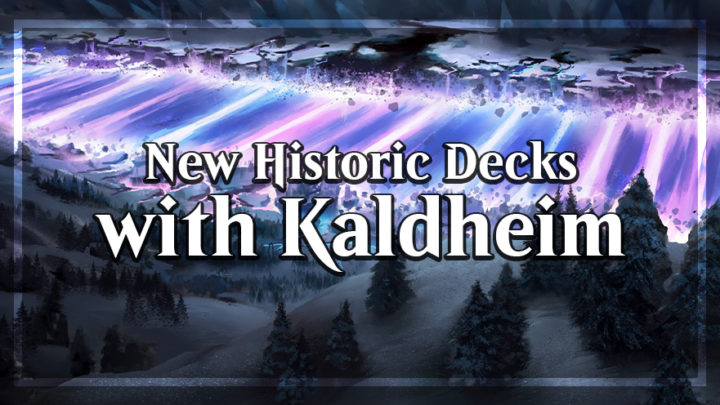New set releases are my favorite times to be playing Magic: the Gathering. For a handful of weeks, everyone is trying new and exciting archetypes with the release of so many new cards. Standard is fresh and exciting again, and everyone seems to be putting a lot of effort into the new and invigorated format.
But where does that leave Historic? While there are clearly existing archetypes that gain a lot from Kaldheim, there are also some new decks with a lot of potential to be aware of going forward. I’m excited to dive into Historic and talk about both existing and new decks today!
Rakdos Sacrifice

If you’ve read any of my recent articles lately, you probably aren’t surprised to see me kicking off this list with Rakdos Sacrifice. It’s one of my favorite archetypes in Historic, and the deck isn’t going anywhere without a significant banning (which seems unlikely at the moment).
Rakdos Sacrifice has seen continued success despite the printing of Yasharn, Implacable Earth in Zendikar Rising, which just goes to show how well this deck can fight through hate cards. Plus, Rakdos got a lot of powerful new options in Kaldheim. In my last article, I discussed Valki, God of Lies’ potential in this deck, and so far, I’ve been enjoying it. The card is its most powerful against Uro, Titan of Nature’s Wrath, so I am currently opting to have it as a sideboard card.
Two other cards I’ve been impressed with in Kaldheim for Rakdos Sacrifice are Immersturm Predator and Kardur’s Vicious Return. Unfortunately, since both cards cost a hefty four mana, there isn’t room for both of them in the deck. While you can split up the numbers to play both, Immersturm Predator is the real winner, in my opinion. An evasive threat that is also a sacrifice outlet is hard to compete with. While sacrifice sources are extremely important in these sorts of decks, this card’s biggest strength is its ability to exile cards from graveyards (I’m looking at you, Uro). As a bonus, Immersturm Predator survives board wipes too like Wrath of God, Doomskar, and Anger of the Gods! If you’ve been playing RakSac as much as I have, I highly recommend adding this card to your list.
Jeskai Lotus Field
Jeskai Lotus Field decks have been picking up in popularity, especially in the weeks leading up to the release of Kaldheim. This might be the biggest winner from the release of Kaldheim, ascending from the fringes of Historic into tier one. How did this happen? There are three new cards that shine in this deck, and they all have the new foretell mechanic.

First, it’s important to understand why cards with foretell are good in this archetype. Jeskai Lotus Field often won’t have any plays to make in the first two turns in the game, and this puts you far behind to any deck with an explosive start. With foretell cards, you finally have consistent turn two plays, and the relatively low foretell costs of these spells will allow you to make a bigger impact earlier in the game.
The best example here is Doomskar. Anger of the Gods and Sweltering Suns were good removal spells on turn three, but sometimes, they’re not good enough against Gruul Aggro. With Doomskar, it doesn’t matter if your opponents’ creatures have more than three toughness. Foretelling Doomskar on turn two also gives you options for your following turns. Do you want to take a turn off and see if your opponent will commit more to the board? Can you survive an extra turn to play Blood Sun? There are a lot of factors to consider with when to use the cards you foretell, and often in Magic, having access to as many options as possible is one of the best spots you can be in.
A few weeks back, I talked about the potential of Starnheim Unleashed in a Lotus Field deck, and so far, it has met my expectations. Lotus Field decks’ game plan is to accelerate their mana by playing Lotus Field after playing Blood Sun or by casting Tale’s End to stifle Lotus Field’s enter the battlefield trigger. Because of this, the deck can play cards with high CMC’s surprisingly quickly. A card like Starnheim Unleashed fits perfectly in the deck when you can sink excess amounts of mana into casting the spell for its foretell cost.
I’m also excited to play Alrund’s Epiphany in this sort of deck. This card might be too cute for the archetype, but I like the idea of having a “take an extra turn” effect in this deck. You can save this card for when you need an extra turn to survive, when you have a good setup turn to take, or when you have lethal the following turn. I’m trying one copy in the deck right now, and I’ve been impressed with it so far.
Golgari Elves
Tribal strategies in Historic have been almost non-existent, partially because they’ve been outclassed by Goblins — the most powerful tribe in the format. Additionally, Elves and Spirits have had a few cards missing to fill the holes in the decks. Before Kaldheim released, Elves was close to being a competitive strategy; while the deck was quick and aggressive, it was missing some cards to really give it a push into the competitive tiers of Historic. This archetype got a handful of upgrades with Kaldheim, and it’s looking very promising so far.

Skemfar Avenger is the first notable new card for Elves. One struggle that the archetype had was not being able to recover from a board wipe. Skemfar Avenger allows you to risk overextending because you get to immediately refill your hand and play a handful of creatures the following turn. This card alone is worth splashing black for, as board wipes are often the best hate cards against Elves.
Elvish Warmaster is another good addition to the archetype. This is a great support card for a “go-wide” strategy because it essentially doubles the number of elves you can put on the board. Elvish Warmaster’s ability isn’t that difficult to activate, either, especially when you have Elvish Archdruid in play.
My favorite card for Elves in Kaldheim is Realmwalker, which serves as an honorary elf because of its changeling ability. Much like Conspicuous Snoop in Goblins, Realmwalker enables extremely powerful and proactive turns by allowing you to dump as many elves as possible into play from the top of your library. This is another card that helps you rebuild quickly after a board wipe.
The additions to Elves from Kaldheim also benefit this deck by making it more resistant to hate cards. Being able to combat interactive decks by rebuilding board presence and maintaining card advantage pushes this deck from tier three to maybe even tier one. I have been increasingly impressed with this deck, and not enough people are talking about it.
Bant Spirits
Bant Spirits has always been very close to being competitive in Historic. Unfortunately, since Shadows Over Innistrad block is not legal in Historic, the archetype lacks staples of its Modern and Pioneer counterparts, like Spell Queller and Mausoleum Wanderer. While Historic Bant Spirits cannot function like the Modern version, the deck keeps gaining potential each time a new set is released.

For Spirits, the new cards I’m interested in trying out are Cosima, God of the Voyage and Realmwalker. Realmwalker seems like a great upgrade for any tribal deck that can support green. Having access to an additional play or two per turn helps you make important decisions and dictate the pace of play during the game. Additionally, it gives you extra information: if you have Skyclave Apparition as a removal spell, if you have the ability to give a creature hexproof with Rattlechains, or if you want to get aggressive and play a creature that increases your creatures’ power and toughness like Supreme Phantom or Empyrean Eagle.
Cosima, God of the Voyage is one of the most complicated cards we’ve seen in a long time. Essentially, she gets voyage counters while she is in exile, and when you return her to the battlefield, you draw cards. This is another way to maintain card advantage, and it’s a good way to refuel your hand and give you additional options.
Honorable Mention: Four-Color Midrange
While this deck didn’t necessarily gain any new cards in Kaldheim, this is the go-to midrange deck in the format going forward. Since Jund and Rakdos Sacrifice have been seeing continued success against Sultai Midrange, I recommend going back to Four-Color Midrange to combat these decks with Yasharn. Four-Color Midrange loses the edge in the “mirror” against Sultai Midrange, but takes the upper hand against other decks. If you’re low on wildcards and aren’t able to incorporate Kaldheim into your decks, this is where I would start in Historic.

***
As the Historic card pool grows, it’s always a guessing game to see which new cards (if any) will affect the format. This time, there are a lot of cool new cards in Kaldheim that seem to be making a big impact in Historic, both in new and old archetypes. I’m really excited to keep exploring Historic and playing with the new cards. I think there is also a good Yorion, Sky Nomad deck out there, but I will need to put some extra work into building and testing lists. Check back in the following weeks to see what I come up with!

Ally Warfield is a member of the Rivals League, a full-time streamer, and a Splinter Twin apologist. Her focus is in Historic and Standard, but she also loves to dabble in Vintage and Limited formats as well.

